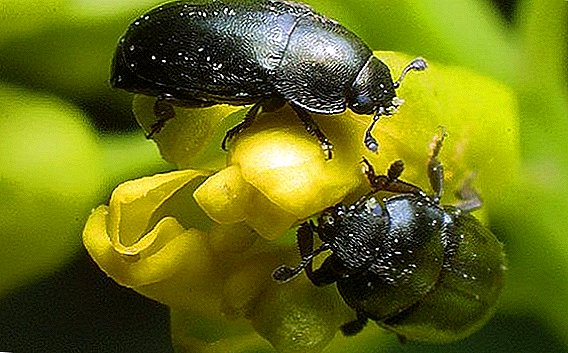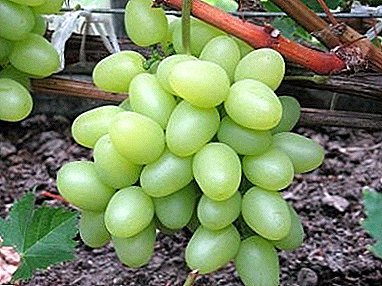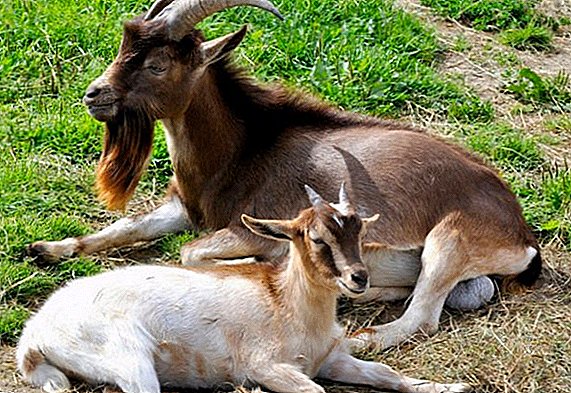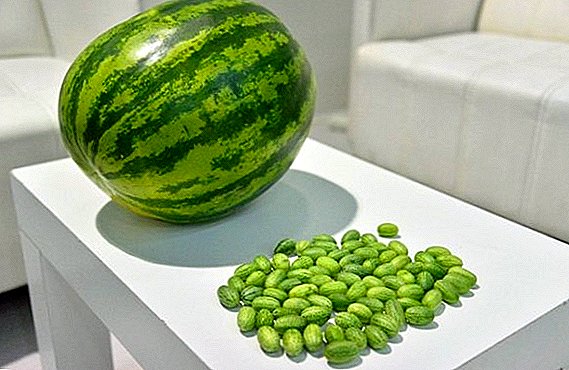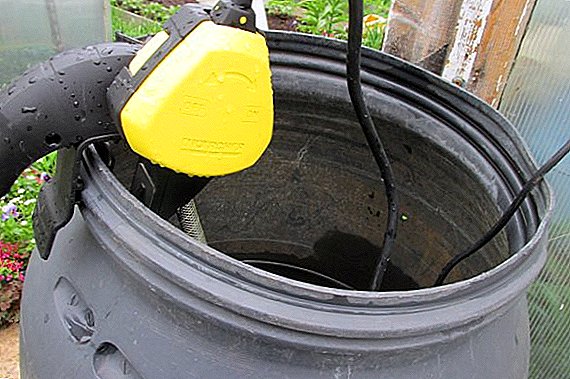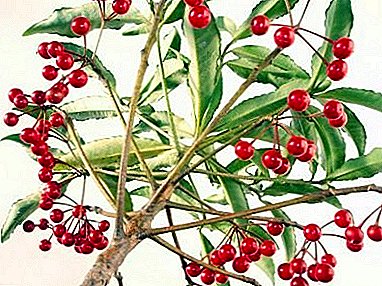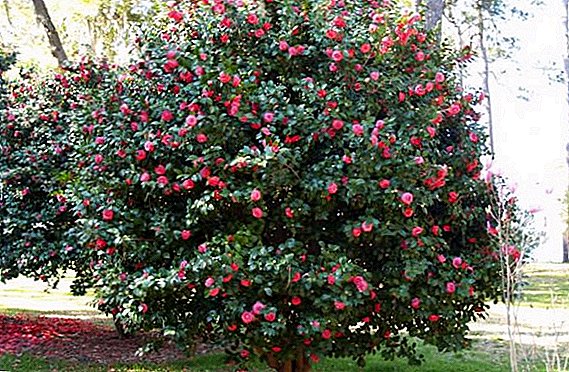 Camellia is a valuable decorative representative of the flora, it is very popular for growing as a houseplant and in open ground conditions in greenhouses and gardens.
Camellia is a valuable decorative representative of the flora, it is very popular for growing as a houseplant and in open ground conditions in greenhouses and gardens.
It is an evergreen flowering shrub, at least - a tree, up to 20 meters high. Today, more than 80 species of this plant are known, which, in turn, have many varieties.
The flowering period of many varieties of more than six months, so the view certainly deserves attention. Next, find out where the camellia grows, get acquainted with its interesting species.
Japanese (Camellia japonica)
 This plant is originally from northwestern China and Japan, is found in Taiwan, South Korea, and Shandong. The area of growth in the wild - the southern regions with a temperate and humid climate at an altitude of 250 to 1100 meters. As a rule, the height of a bush or tree is from 1 to 5.5 meters. In rare cases for this type of camellia, it can reach 11 meters.
This plant is originally from northwestern China and Japan, is found in Taiwan, South Korea, and Shandong. The area of growth in the wild - the southern regions with a temperate and humid climate at an altitude of 250 to 1100 meters. As a rule, the height of a bush or tree is from 1 to 5.5 meters. In rare cases for this type of camellia, it can reach 11 meters.  Japanese camellia crown is sparse, but at the same time rather voluminous. The leaves are dark green in color, have a length of 5 to 10 cm and a width of 6 cm, oval, pointed. Flowers with a diameter of no more than 4 centimeters, one or more, appear from the leaf sinuses. In garden varieties, they are much larger - from 7 to 11 centimeters
Japanese camellia crown is sparse, but at the same time rather voluminous. The leaves are dark green in color, have a length of 5 to 10 cm and a width of 6 cm, oval, pointed. Flowers with a diameter of no more than 4 centimeters, one or more, appear from the leaf sinuses. In garden varieties, they are much larger - from 7 to 11 centimeters
Did you know? For the first time the plant is mentioned in writing in Japan in the 1st century AD. And only in the XVII century it was brought to Europe and described by the Jesuit monk Georg Joseph. Kammelus (1661-1706). The name is given from his last name.
The species is the ancestor of a thousand and a few varieties of garden camellia, therefore the variety of its flowers is wide in shape and color. In form, they are simple, terry in half, terry kind of roses, terry symmetrically, type of anemones and type of peony. The color scheme is all shades of pink and red, white, cream and bright yellow.
Important! All kinds of acid cultures. Growing will be successful only in the case of soil acidity pH 4.5-5.5.
Varieties popular in cultivation:
- 'Pink Perfection' - flowers terry, light pink.
- 'Chandlers Red' - dark red flowers with wide petals.
- 'Linda Rosazza' - half double flowers of white color.
- 'Margaret Davis' - flowers half terry with bright crimson edging.
- `Tricolor` -flowers with bright red blotches and bright yellow center.





Camellia japonica blooms from October to April. There should be enough sun and moisture in a temperate climate.
Read also about the cultivation and varieties of Japanese spirea.
Chinese, or tea bush (Camellia sinensis)
 It was the Camellia sinensis tea shrub that brought the genus world fame. The first cultivation was in China, and then in Japan. At the beginning of the XIX century it was continued to be cultivated in India and on the island of Java.
It was the Camellia sinensis tea shrub that brought the genus world fame. The first cultivation was in China, and then in Japan. At the beginning of the XIX century it was continued to be cultivated in India and on the island of Java.  In addition to these regions, today large plantations of camellia chinese are also located in Sri Lanka, in some regions of South Africa and South America, in the south of several European countries, in Georgia, Azerbaijan and the Krasnodar Territory of the Russian Federation.
In addition to these regions, today large plantations of camellia chinese are also located in Sri Lanka, in some regions of South Africa and South America, in the south of several European countries, in Georgia, Azerbaijan and the Krasnodar Territory of the Russian Federation.  Tea bushes in nature are rarely high, but individual specimens can still grow up to 10 meters. The length of the sheet varies from 5 to 7 centimeters, and the width does not exceed 4 cm. They are oval, slightly longish, dark green in shape. Flowers are small, up to 3 centimeters, very reminiscent of jasmine flowers. Occur in white and less often in pale pink color, middle with bright yellow stamens.
Tea bushes in nature are rarely high, but individual specimens can still grow up to 10 meters. The length of the sheet varies from 5 to 7 centimeters, and the width does not exceed 4 cm. They are oval, slightly longish, dark green in shape. Flowers are small, up to 3 centimeters, very reminiscent of jasmine flowers. Occur in white and less often in pale pink color, middle with bright yellow stamens.
Did you know? Of all the large number of flowers, only 2-4 percent bear fruit.
Fruits are dark brown to 1 centimeter in diameter. They are successfully used for growing the tea plant in the home and greenhouses.  From the name it is obvious that the leaves are used for making everyone's favorite tea, and from the seeds they get oil, which is used both for technical purposes and for consumption.
From the name it is obvious that the leaves are used for making everyone's favorite tea, and from the seeds they get oil, which is used both for technical purposes and for consumption.
Japanese Kerria - flowering shrubs, which are often found in the decor of the park, garden or courtyard. The plant is well acclimatized in different conditions and unpretentious in the care.
Mountain, or camellia sasanqua (Camellia sasanqua)
 Mountain camellia has another name - carp. She was brought to Europe from East and Southeast Asia. "Mountain tea that blooms beautifully" - this is how the name of this plant is translated from Japanese. Chinese and Japanese mountains differ from their sisters in short stature - its height does not exceed 5 meters.
Mountain camellia has another name - carp. She was brought to Europe from East and Southeast Asia. "Mountain tea that blooms beautifully" - this is how the name of this plant is translated from Japanese. Chinese and Japanese mountains differ from their sisters in short stature - its height does not exceed 5 meters.  The leaf, in addition to the usual dark green color, has a slightly fluffy dark vein below. Its length is up to 7 and the width is up to 3 centimeters. This type of camellia is well grown in all conditions - in the house, greenhouse, garden.
The leaf, in addition to the usual dark green color, has a slightly fluffy dark vein below. Its length is up to 7 and the width is up to 3 centimeters. This type of camellia is well grown in all conditions - in the house, greenhouse, garden.
Sazanka begins to bloom in November and finishes in December, therefore it received the name "flower of the autumn sun". From this species, slightly more than one hundred varieties have been cultivated by cultivation. Because of its short stature, dwarf varieties are well cultivated from the sazan.
We advise you to read about growing on a site of Japanese quince.
Saluenska (Camellia saluenensis)
 This interesting species of bush camellia was first introduced by George Forest in 1917. The homeland of this plant is the Chinese provinces of Yunnan and Sichuan, where it grows in mixed forests and on mountain slopes at an altitude of 1200-2800 meters.
This interesting species of bush camellia was first introduced by George Forest in 1917. The homeland of this plant is the Chinese provinces of Yunnan and Sichuan, where it grows in mixed forests and on mountain slopes at an altitude of 1200-2800 meters.  Bushes up to 4 meters high, compact, with a branchy crown. Sheet length 2.5-5.5 cm, width - up to 2.5 cm, they are oblong-elliptical in shape. Flowers are white or pink with yellow stamens, up to 5 cm in diameter.
Bushes up to 4 meters high, compact, with a branchy crown. Sheet length 2.5-5.5 cm, width - up to 2.5 cm, they are oblong-elliptical in shape. Flowers are white or pink with yellow stamens, up to 5 cm in diameter.
From this species, many varieties of garden camellia have been bred that tolerate a cold climate well and bloom longer than others. The most famous is Williams hybrid. It is obtained by crossing the Saluen and Japanese species.
We recommend that you familiarize yourself with beautiful flowering shrubs for your garden: hydrangea, viburnum buldenezh, spirea, deicia, magnolia, lilac, chubushnik.
Mesh (Camellia reticulata)
 The habitat of camellia netted is limited to Yunnan province, south-west of Sichuan province and west of Guizhou province in southern China. This species is different from the others by the largest sizes of both a flower and a plant. The height of such a bush or tree reaches 15-20 meters, and the flower can be up to 23 centimeters in diameter.
The habitat of camellia netted is limited to Yunnan province, south-west of Sichuan province and west of Guizhou province in southern China. This species is different from the others by the largest sizes of both a flower and a plant. The height of such a bush or tree reaches 15-20 meters, and the flower can be up to 23 centimeters in diameter.  The flowers have a subtle net surface - hence the name. In the 20s of the 17th century, one of the varieties of Camellia reticulata was brought to the capital of Albion. After 6 years, the tree blossomed and made a sensation in the gardening community.
The flowers have a subtle net surface - hence the name. In the 20s of the 17th century, one of the varieties of Camellia reticulata was brought to the capital of Albion. After 6 years, the tree blossomed and made a sensation in the gardening community.
Did you know? Trees of reticulated camellia were made to be planted on the territory of Buddhist monasteries. The age of one such tree with the name "Ten Thousand Flowers" growing in a Buddhist temple near the city of Liyan is more than 500 years old.
Golden-flowered (Camellia chrysantha)
 Golden Camellia of China - so called species with the bright name of golden-flowered. During the flowering period, it is striking in its beauty, because almost simultaneously more than 200 yellow flowers bloom. Growth is limited to Guangxi Province in China.
Golden Camellia of China - so called species with the bright name of golden-flowered. During the flowering period, it is striking in its beauty, because almost simultaneously more than 200 yellow flowers bloom. Growth is limited to Guangxi Province in China.  The plant reaches a height of up to 5 meters, grows in forests in areas of high humidity. Camellia chrysantha is on the verge of extinction, therefore it is listed in the Red Book in 2006.
The plant reaches a height of up to 5 meters, grows in forests in areas of high humidity. Camellia chrysantha is on the verge of extinction, therefore it is listed in the Red Book in 2006.
The blooming of spray roses is an incredibly beautiful sight. Learn how to grow flowers in your garden.
Williams Hybrid (Camellia x williamsii)
 Williams Hybrid is famous, first of all, as the first obtained by crossing Japanese and Saluen species in the 30s of the last century by gardener John Charles Williams.
Williams Hybrid is famous, first of all, as the first obtained by crossing Japanese and Saluen species in the 30s of the last century by gardener John Charles Williams.
Camelia Williams is considered the best for growing in greenhouses and open ground due to its endurance and longer flowering period. It is a dense bush up to 1.8 meters high and up to 1.2 meters wide with a flower diameter up to 15 centimeters. Williams hybrid can withstand temperatures down to minus 20 degrees.
The color of flowers is as diverse as that of her Japanese mother - from pale pink to bright red, white, cream. Due to the great popularity of more than 100 varieties of Williams hybrid. Here are some of them:
- Camellia x williamsii 'Anticipation';
- Camellia x williamsii 'China Clay';
- Camellia x williamsii 'Debbie';
- Camellia x williamsii 'Donation'.




Important! The plant is a real find for allergies. It is practically odorless.
Argued that camellia is very difficult to grow. But professionals argue that, apart from good watering and compliance with recommendations for soil acidity, the plant does not need special care. The variety of species, flowers, sometimes resembling a rose, a long flowering period will make this representative of the tea family a luxurious decoration of a garden or interior.


